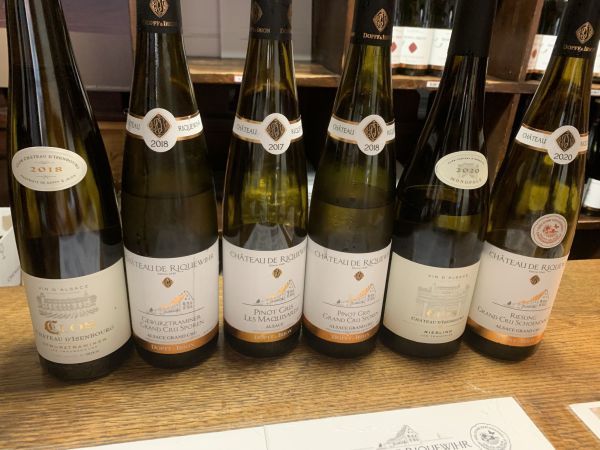
Alsace is the driest part of France, sheltered from the rain by the Vosges mountains. It is also in the East of France, and ends at the river Rhine which also forms the border with Germany. Historically, Alsace was German and Germanic influences can still be seen in the pretty “fairy-tale” architecture, the cuisine and most importantly the wine!
The wines of Alsace are overwhelmingly white with a little red wine made from Pinot Noir. There is also a significant amount of sparkling wine – Cremant d’Alsace, made by the traditional method and excellent value for money.
Alsace wines are (by law) served in the German style tapered “flute” bottle, and unusually for French wines, clearly display the grape variety on the label. The Appellation Controlee system in Alsace is (currently) also very simple with a generic Alsace AC, plus ACs for each of the 51 Grand vineyards (plus one extra to cover Cremant), making 53 in total. There are plans afoot to introduce some individual village and Premier Cru ACs, which would mimic the (very confusing) Burgundy set-up. Fortunately for us consumers, these plans remain largely on the drawing board. One thing that is notable in Alsace however is the concept of “Lieu-dit” where specific vineyards are named on the label. This of course does NOT necessarily mean that the wine is of higher quality (but in practice it usually is).
Of the principle white grape varieties, the widely planted Pinot Blanc can make decent quality wine but rarely reaches the heights of the four “noble” varieties – Muscat, Gewurztraminer, Pinot Gris and Riesling.
Muscat in Alsace is dry and aromatic. It’s an interesting wine but there is very little of it as it is very fussy about vineyard location and it is prone to disease.
Gewurztraminer is probably the variety most associated with Alsace. Despite its name, when Alsace became French it took almost all German plantings of this variety with it. It is highly aromatic with roses, stone/tropical fruit and spices prevalent on the nose. Its acidity is usually quite low, with a full-body and quite high alcohol. It would be even higher, if it were not for the fact that fermentation is stopped to retain some sweetness.
Pinot Gris is the Alsace name of the more familiar Pinot Grigio. A far cry from the Italian style, here in Alsace with its long, dry autumns, this variety produces wines of great complexity and depth, lower acidity, more body and usually a touch of sweetness too.
However, the truly great variety of Alsace is Riesling. Another variety indigenous to Germany, the Alsace style is quite different from those produced on the other side of the Rhine. Here the wines are always dry, often with quite high alcohol. The characteristic high acidity is balanced not by sugar but be intense concentration of flavours such as blossom, apple, lime, peach and given time, that tell-tale petrol. In Alsace, it is Riesling that is regarded as the best wine to drink with meals.
Three to try
Domaine Schlumberger ‘Spiegel’ Pinot Gris Alsace Grand Cru AC 2019. A wine of great texture and depth of flavour, this Pinot Gris is at once youthfully vibrant, harmonious and mature. The palate is full of ripe white fruit, with finely balanced sweetness and acidity. (Majestic Wine, £17.99)
Cuvée René Dopff, Dopff & Irion, Riesling, Alsace AC 2019. A wonderful aroma of green apples and vine flowers on the nose with a hint of petrol in the back-ground. The palate is fresh and racy with citrus fruit joining the apples and floral character of the nose. (Tanners Wines, £13.99).
Taste the Difference Gewurztraminer, Alsace AC 2020. Bursts with notes of rose petals, exotic lychees & spices. Rich & aromatic with a fresh finish. (Sainsburys £10.00)

.jpg)
.jpg)
.jpg)